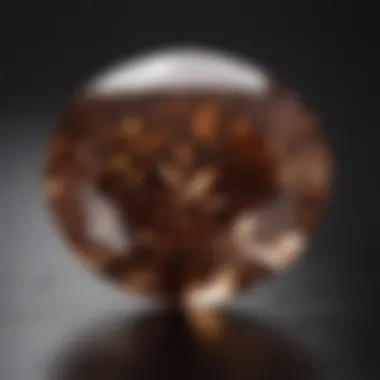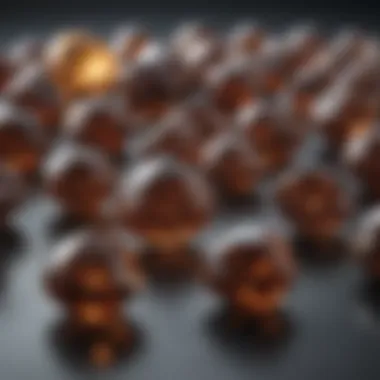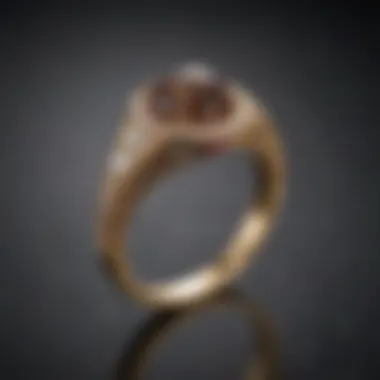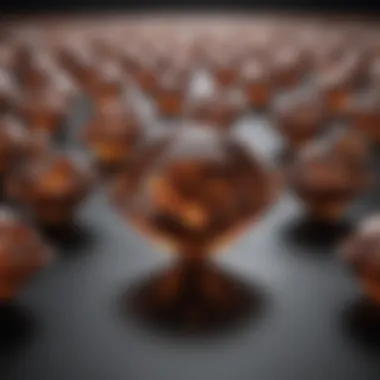Understanding the Worth of a 1 Carat Chocolate Diamond


Intro
Gemstone Overview
Definition of Gemstones
Gemstones are minerals or rocks that are cut and polished into a piece suitable for jewelry or ornamental use. They can also be organic materials, such as pearls or amber. Gems are valued based on several characteristics, including their rarity, aesthetic qualities, and durability. Color, clarity, cut, and carat weight are crucial metrics when assessing their worth.
Classification of Gemstones
Gemstones are categorized into two main groups: precious and semi-precious. Traditionally, precious stones include diamonds, rubies, sapphires, and emeralds. Semi-precious stones consist of a much larger category, which includes amethyst, topaz, and garnet, among others. Chocolate diamonds fall under the diamond category but are considered less traditionally valuable compared to colorless diamonds. However, they have a niche market.
Historical Significance
Origins of Gemstone Use
Gemstones have been valued since ancient times for their beauty and supposed protective qualities. Cultures worldwide revered gemstones, not only for adornment but also for their symbolic meanings. Diamonds, in particular, have a storied history dating back thousands of years, prized by rulers and elites.
Cultural Insights: Gemstones in Ancient Civilizations
In ancient civilizations, gemstones were often linked with commands of power and spirituality. For example, in Egypt, the Pharaohs adorned themselves with gemstones believed to hold divine properties. Similarly, ancient Indians regarded diamonds as the manifestion of the physical and spiritual essence of life. This historical context illuminates how gemstones have been perceived and valued through time, ultimately influencing modern market dynamics.
"The historical context of gemstones enriches the meaning behind their value and desirability in the current market."
Understanding the historical significance of gemstones, especially chocolate diamonds, allows collectors and enthusiasts to appreciate their worth beyond mere pricing metrics. The unique narrative around each stone can enhance its desirability significantly.
In the following sections, we will delve deeper into the specific valuation factors related to 1 carat chocolate diamonds such as market trends and pricing metrics.
Foreword to Chocolate Diamonds
The realm of gemstones is filled with significant choices, and one that stands out for its rarity and allure is the chocolate diamond. In this section, we will explore the very essence of chocolate diamonds, an important topic for both enthusiasts and prospective buyers. Understanding their unique traits and historical significance helps one appreciate their value beyond mere aesthetics.
When it comes to distinguishing chocolate diamonds from other diamond varieties, the main aspect to highlight is their unique color. Chocolate diamonds are famous for their rich brown hue, which sets them apart in both the market and in personal collections. Understanding this characteristic is vital, as it affects both consumer interest and the pricing of these gems.
Additionally, examining the historical context of chocolate diamonds reveals their journey from obscurity to high demand. Knowing the evolution of these diamonds through time can also inform potential buyers about trends in value and market perception. Chocolate diamonds are gaining popularity, and discussing this interest helps cement their place in the contemporary jewelry market.
Defining Chocolate Diamonds
Chocolate diamonds are, in essence, natural diamonds that possess a brown color ranging from lighter shades to deep, rich tones. The term "chocolate diamond" is a marketing term that conveys beauty and uniqueness. The gem quality of each stone is assessed through standards that cover aspects like color intensity, clarity, and cut. Unlike traditional white diamonds, the chocolate variant falls under a separate classification by the Gemological Institute of America, which helps in its identification.
The categorization of brown diamonds into various shades enables a deeper understanding of their value. A key point to remember is that not all brown diamonds are regarded as chocolate diamonds. The distinction is based on the appeal of the color, which must evoke warmth and richness reminiscent of the confectionery treat it’s named after.
Historical Context
The history of chocolate diamonds is rather fascinating. These gems were often overlooked in favor of vibrant colored stones and classic white diamonds. However, shifts in consumer preference have brought chocolate diamonds into the spotlight. Originally, their brown hue was viewed as undesirable, which heavily influenced market perception.
Over the past few decades, efforts by some leading jewelers and brands have changed this narrative. Notably, the initiatives from the Le Vian company in particular helped in elevating the chocolate diamond from obscurity to popularity.
As tastes change, understanding the backdrop of these diamonds helps collectors and aficionados appreciate the journey and investment potential.


"The evolution of chocolate diamonds illustrates how market dynamics can drastically shift perceptions and value."
Understanding Diamond Carat Weight
Understanding diamond carat weight is foundational when it comes to evaluating the worth of a 1 carat chocolate diamond. Carat weight refers specifically to the weight of the diamond and is a crucial determinant in its pricing and perceived value. This section will decode the nuances of carat weight, clarifying its significance and impact on the overall assessment of chocolate diamonds.
What is a Carat?
A carat is a unit of measurement used to weigh gemstones, where one carat is equal to 200 milligrams. The term derives from the carob seeds that were historically used as balance scales in weighing gems. Each increase in carat weight can significantly alter a diamond's market value. For chocolate diamonds, which are naturally colored, the 1 carat mark also holds special meaning. It is a commonly sought-after size for engagement rings and other fine jewelry, striking a balance between presence and accessibility.
Understanding the carat weight of a chocolate diamond involves more than just its mass. The diamond’s cut, clarity, and color all play essential roles in how this weight is perceived. For instance, two diamonds with the same carat weight may appear different sizes due to variance in cut, thereby influencing consumer choice and seller valuations.
Impact of Carat on Value
The impact of carat weight on the value of a chocolate diamond is profound and multi-dimensional. Here are the main factors to consider:
- Market Trends: Generally, larger carat weights correlate with higher prices. A 1 carat chocolate diamond will usually attract more interest than smaller versions, primarily due to the luxury perception surrounding more substantial stones.
- Comparative Pricing: The price per carat does not remain constant. It tends to increase exponentially with size. Thus, a 2 carat chocolate diamond often costs significantly more per carat than a 1 carat version.
- Consumer Demand: The demand for chocolate diamonds has seen a rise, particularly among consumers looking for unique and distinct options compared to traditional clear diamonds. This growing interest affects how 1 carat chocolate diamonds are valued in the marketplace.
"The value of a diamond is determined by its carat weight, but this weight also interacts with other essential factors like clarity and color."
Factors Affecting the Value of a Chocolate Diamond
The value of a chocolate diamond extends beyond mere carat weight. Understanding its worth involves multiple factors that work in concert. For buyers and investors, knowledge of these factors is crucial, as they can greatly influence market perception and pricing. By dissecting elements like color classification, clarity, and cut quality, one gains a fuller picture of what defines a chocolate diamond’s value. Each factor contributes to both the diamond's aesthetics and its market appeal.
Color Classification
Color classification is vital when assessing a chocolate diamond's value. Unlike traditional diamonds, which are graded on a D to Z scale based on their colorlessness, chocolate diamonds are categorized by the richness of their brown hue. The most sought-after chocolate diamonds exhibit deep, vivid color tones, which can enhance their desirability.
"The color's intensity can lead to significant price variances, with deeper shades typically commanding higher values.”
Chocolate diamonds typically fall into several classifications: light brown, fancy brown, and dark brown. The specific hue can create variations in market demand. Buyers often prefer stones that have a uniform and rich color. Jewelers may refer to grading systems developed by organizations like the Gemological Institute of America (GIA) to provide clarity around these classifications.
Clarity and Its Significance
Clarity plays a critical role in determining the value of chocolate diamonds, just as it does in traditional gemstones. Clarity refers to the presence of inclusions or blemishes that can affect the diamond's visual appeal. Unlike larger diamonds where inclusions may be more noticeable, chocolate diamonds can sometimes mask these imperfections due to their darker tones. However, clarity is still a significant factor in pricing and desirability.
A diamond with few inclusions often commands a higher price. Jewelers evaluate diamonds based on a clarity scale that rates them from Flawless (no inclusions visible) to Included (inclusions visible to the naked eye). Collectors and enthusiasts often seek diamonds that rank higher on this scale, regardless of their color.
Cut Quality and Market Perception
The cut quality of a chocolate diamond is equally important in shaping its value. The cut influences how well the diamond reflects light, which can significantly impact its overall appearance. A well-cut diamond maximizes brilliance and scintillation, enhancing its visual appeal. Poorly cut diamonds, on the other hand, may appear dull, regardless of their other qualities.
Moreover, market perception of cut quality can greatly influence pricing. The standards vary among jewelers and manufacturers; hence, a diamond that is cut to ideal specifications may be priced higher. Understanding the standards used for grading cut quality can provide insights into why some chocolate diamonds are more valuable than others.
Market Demand for Chocolate Diamonds
Understanding the market demand for chocolate diamonds is pivotal in grasping their overall value and appeal. The market dynamics influence how these unique gemstones are perceived and, consequently, their pricing. As consumer interest shifts towards personalized and distinctive jewelry pieces, chocolate diamonds have carved out a niche that represents both luxury and individuality. This section delves into current trends and consumer preferences to illuminate why chocolate diamonds are in demand today.
Current Trends in Jewelry
Recent changes in the jewelry market have seen a growing inclination towards unconventional stones. Chocolate diamonds have gained attention for their rich hues and uniqueness. This trend is partially fueled by a desire for a departure from the traditional clear diamond. Consumers are now looking for pieces that tell a story or represent their personality.


- Sustainable sourcing: Ethical considerations play a significant role. Buyers are increasingly aware of the origin of diamonds. Chocolate diamonds are often marketed with a focus on conflict-free sourcing, appealing to conscientious consumers.
- Customization: Many buyers prefer bespoke jewelry. Chocolate diamonds lend themselves well to custom designs that fit the buyer's style, solidifying their place in the market.
- Celebrity endorsements: Public figures have championed chocolate diamonds through various events. This kind of visibility reinforces the desirability of these stones.
As we observe these trends, it becomes evident that the demand for chocolate diamonds is not just a fleeting interest. It reflects broader shifts in consumer values and market strategies.
Consumer Preferences
Consumer choices shape the landscape of jewelry purchasing. Chocolate diamonds have become symbolic of personal expression. This categorically distinguishes them from their traditional counterparts.
Several factors drive consumer preferences:
- Aesthetic Appeal: The unique brown tones of chocolate diamonds attract those seeking something different. The earthy color can complement various metals, particularly rose gold, enhancing its visual appeal.
- Value Perception: Many consumers believe they receive better value for chocolate diamonds. Often, chocolate diamonds are priced lower than traditional diamonds of the same carat weight, making them an economical choice for those who want to own a worthwhile gem without the steep price.
- Emotional Connection: People often seek pieces that resonate personally. Among consumers, chocolate diamonds convey warmth and rarity, contributing to their emotional attachment and willingness to invest in such stones.
"Chocolate diamonds exude a warmth and character often lacking in traditional diamonds, leading to a more meaningful connection with their wearers."
Comparative Pricing: Chocolate vs. Traditional Diamonds
The comparative pricing of chocolate diamonds against traditional diamonds is an essential aspect of understanding their market value. Chocolate diamonds, known for their rich brown hues, offer a unique alternative to the more widely recognized clear diamonds. This section delves into the price variations and the factors influencing these differences.
When consumers choose diamonds, they often consider aesthetics, symbolism, and investment potential. It is crucial to grasp how chocolate diamonds stand in contrast to their colorless counterparts. This comparative analysis can guide informed purchasing decisions, whether for personal use or as an investment.
Price Comparisons
The pricing of diamonds is influenced by several key factors, including color, clarity, carat, and cut. When examining price comparisons, it’s important to highlight the following points:
- Market Trends: Traditional diamonds generally command higher prices due to established market expectations and a longstanding historical value.
- Color Impact: Chocolate diamonds, while gaining popularity, still have a lower average price per carat than traditional diamonds. This is partly due to the market's perception of brown diamonds as less desirable.
- Rarity Factor: Clear diamonds, particularly those with high clarity ratings, are considered more rare and, thus, fetch higher prices. Chocolate diamonds are more abundant, resulting in lower prices.
Typically, a 1 carat chocolate diamond may range from $1,500 to $3,000 while a traditional diamond of the same carat weight can cost significantly more, often starting near $5,000.
Factors Contributing to Price Differences
Several factors influence the price disparity between chocolate diamonds and traditional diamonds:
- Color Grading: Chocolate diamonds are graded on a scale of 1 to 5 based on their brown color intensity. Higher grades can approach the lower ends of traditional diamond prices but rarely surpass them.
- Consumer Awareness: Varying degrees of market knowledge and cultural perceptions about chocolate diamonds compared to traditional stones affect their pricing. As consumer awareness increases, chocolate diamonds may gain value over time.
- Resale Value: The resale market for traditional diamonds is more robust. Chocolate diamonds have fluctuating resale values, which can impact their attractiveness to investors.
"Understanding the nuances of diamond pricing is pivotal for anyone looking to invest in or purchase diamonds. Knowing the value of what you are buying can change the perception and quality of your investment."
The exploration of these factors provides valuable insights for those interested in the jewelry market. Collectors and jewelry designers may find chocolate diamonds appealing for their unique qualities and lower price point. Yet, it is necessary to remain aware of how market dynamics influence both varieties of diamonds. By unpacking the complexities of pricing, potential buyers can make more informed decisions.
Evaluating the Investment Potential
When considering a 1 carat chocolate diamond as an investment, understanding its potential value is crucial. Chocolate diamonds, known for their unique brown hues, have garnered attention in recent years. However, investment value differs from mere aesthetic appreciation. Thus, it is essential to evaluate several key facets that impact investment decisions, especially for gemstone enthusiasts, collectors, and jewelry designers.
The value of chocolate diamonds hinges on several factors. These factors include resale value, market demand, and the overall appeal of the stone. In addition, prospective buyers need to recognize the nuances that differentiate chocolate diamonds from more traditional options. A comprehensive investment analysis may also include considering market trends and how they influence future prices.
Resale Value Considerations
Resale value is a primary concern for anyone investing in chocolate diamonds. Unlike traditional diamond varieties, chocolate diamonds are not as universally recognized, impacting their resale potential. It’s vital to assess the color quality and certification when considering the future value of the stone. The Gemological Institute of America (GIA) grades diamonds on color, clarity, and cut.
For chocolate diamonds, the color grading is particularly important. Grades can range significantly, which directly influences demand and resale prices. The most sought-after shades are saturated browns, often referred to as "chocolate". If the diamond possesses a higher color quality, it could yield a better resale price.


Furthermore, maintaining possession of the diamond with proper care can enhance its value. Increases in demand for chocolate diamonds may change the resale landscape. Keeping abreast of market trends will assist potential investors in making informed decisions.
"A chocolate diamond’s unique attributes may appeal to niche markets and collectors, which can enhance its resale prospects."
Long-term Market Stability
Long-term market stability for chocolate diamonds is another critical aspect to consider. The gemstone market can be volatile, influenced by various external factors such as economic conditions and consumer preferences. Chocolate diamonds may find more stability as they gain popularity among unique gemstone collectors.
Investors should look at historical pricing trends for chocolate diamonds. Fluctuations in demand can indicate patterns that affect long-term value. Chocolate diamonds may not have the historical investment pedigree of traditional colorless diamonds, yet their increasing recognition could promote a more stable market.
Buyers interested in investment value must also consider how the natural gemstone market is evolving. Environmental sustainability and ethical sourcing are increasingly important in the diamond industry. This focus may lead to a growing preference for unique types like chocolate diamonds, enhancing their market stability over time.
Ultimately, investment in chocolate diamonds requires an examination of both immediate value and long-term market conditions. Engaging with reputable jewelers on trends, maintaining awareness of coloration significance, and understanding consumer preferences are steps that may lead to a sound investment with promising returns.
Where to Purchase a Carat Chocolate Diamond
The purchase of a 1 carat chocolate diamond is a significant decision that requires careful consideration. This section addresses the best places to find these unique gemstones, focusing on their importance not only for value but for quality and authenticity as well. Understanding where to buy such diamonds ensures you are making a well-informed choice, enhancing the overall buying experience.
When investing in a chocolate diamond, you need to consider factors like reputation, price, and authenticity. Purchasing from reputable sources ensures that you get a high-quality product that reflects the proper value for its features. This section delves into both traditional jewelers and online platforms, providing you with the necessary insights to navigate this market safely and effectively.
Reputable Jewelers
Visiting a reputable jeweler is one of the most reliable ways to purchase a 1 carat chocolate diamond. Jewelers with a solid track record offer benefits that you can’t find elsewhere. They usually provide a certificate of authenticity that guarantees the quality and characteristics of the diamond.
Benefits of Choosing Reputable Jewelers:
- Quality Assurance: Established jewelers often carry diamonds that meet specific standards for cut, clarity, and color.
- Customer Service: Knowledgeable staff can guide buyers through the purchase process and help answer questions.
- Return Policies: They typically have customer-friendly return policies, which provide a safety net if the diamond does not meet your expectations.
Some well-known reputable jewelers include Tiffany & Co. and Cartier. However, it's also beneficial to look for local jewelers who may offer personalized service and unique selections.
Online Platforms and Risks
In recent years, online platforms have become a popular choice for purchasing diamonds. Websites like Blue Nile and James Allen provide extensive catalogs, often at competitive prices. However, buying online comes with its own set of risks and considerations.
Risks Associated with Online Purchases:
- Quality Uncertainty: Without seeing the diamond in person, it can be challenging to assess its actual quality and appearance.
- Return Complications: Some online retailers may have strict return policies, complicating the process of getting a refund.
- Potential Fraud: The risk of encountering counterfeit or misrepresented diamonds is higher in online transactions.
When buying a chocolate diamond online, ensure the seller is reputable. Look for positive customer reviews and a clear return policy. Always request certification from recognized gemological organizations.
"The online marketplace can offer great deals, but discernment is crucial to ensure you are investing wisely."
This guide aims to help you understand the different purchasing options available and underscores the importance of thorough research when acquiring your 1 carat chocolate diamond.
Ending
The conclusion serves as an essential summation of the insights gathered throughout this article regarding the value of a 1 carat chocolate diamond. Addressing this section is important because it encapsulates the essential concepts, market factors, and unique characteristics that influence the valuation of these remarkable gems.
Key elements include a reflection on how aspects such as carat weight, color classification, clarity, and cut quality significantly impact the perceived value of chocolate diamonds. Furthermore, understanding how these factors interact with market demands and pricing can help consumers make more informed decisions when purchasing chocolate diamonds.
Summary of Key Points
- Chocolate diamonds, recognized for their unique brown hues, carry distinct characteristics that differentiate them from traditional diamonds.
- Carat weight is a critical factor in determining diamond value, directly affecting price and desirability.
- Color, clarity, and cut quality play indispensable roles in establishing the market value of chocolate diamonds.
- The current market trends show a growing preference for chocolate diamonds among collectors and jewelry enthusiasts, enhancing their appreciation and prestige.
- Understanding the comparative pricing between chocolate and traditional diamonds can provide clarity in value assessment.
- Considerations around resale value and market stability are key for those viewing these diamonds as investments.
Final Thoughts on Chocolate Diamonds
The allure of chocolate diamonds extends beyond mere aesthetics. Their uniqueness adds a layer of charm and individuality that appeals to many collectors and connoisseurs. As the gemstone market evolves, chocolate diamonds have carved out a niche, often symbolizing both luxury and sophistication.



